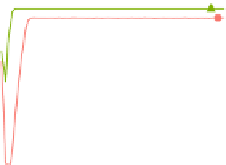Information Technology Reference
In-Depth Information
Both HpHc and HpLc allows cooperation to reach 100%, no matter the group
size and in a quite short amount of time. This is probably due to the fact that
high punishment leads Free-Riders to use up all their resources, while protecting
the other agents. Moreover, once the percentage of tolerated Free-riders goes be-
low the fixed threshold, all the other populations contribute, thus maintaining
cooperation stable and complete.
groups of 5
groups of 10
1.0
0.8
0.6
0.4
Punishment
LpLc
HpLc
LpHc
HpHc
groups of 25
groups of 50
1.0
0.8
0.6
0.4
0
25
50
75
100
0
25
50
75
100
step
Fig. 1.
Cooperation rates over time for different group sizes in mixed populations with
C, FR, TFT, NP and MP. When punishment is costly (HpLc, HpHc), Free-riders are
easily controlled and cooperation can be maintained. When the cost is high and the
punishment is not (LpHc) the cooperation rate is always lower than in the other cases.
Our second experiment was designed to test the effects of information spread-
ing in isolating Free-Riders and maintaining cooperation. We were also inter-
ested in comparing the e
cacy of the two modalities, and to assess which one
worked better. We tested the effectiveness of “Refuse” and “Defect” for different
amounts of information (
i
) available. Manipulating the number of gossips trans-
mitted
{i
=0;1;10
}
for each time-step, we wanted to test whether the amount
of information had an effect on the ability of gossipers to react directly (playing
“Defect”), or indirectly (playing “Refuse”) against Free-riders.
When agents used the “Defect” modality, cooperation rates declined for every
group size. In the “Defect” modality (upper part of Figure 2), cooperation rates

























































































































































































